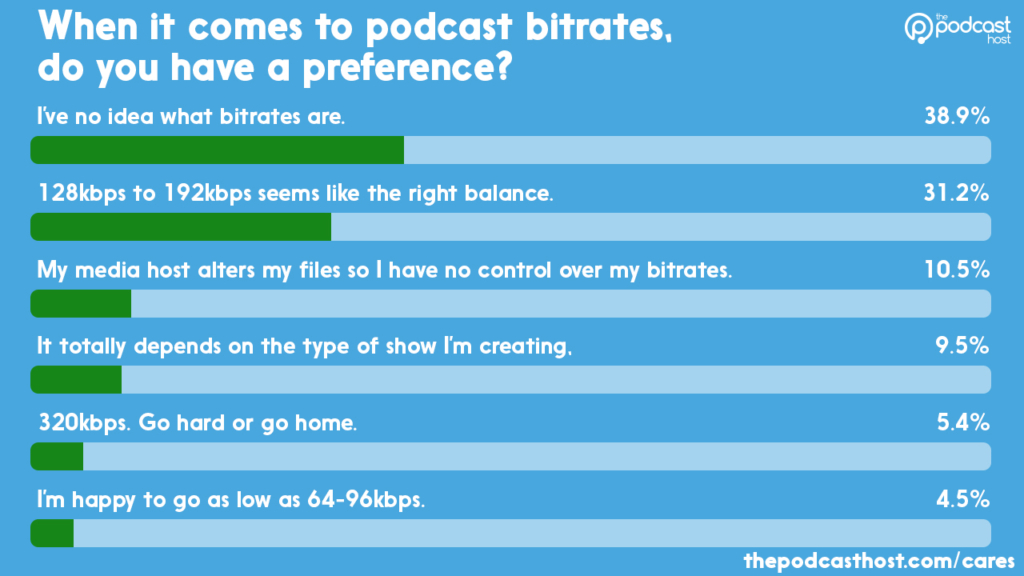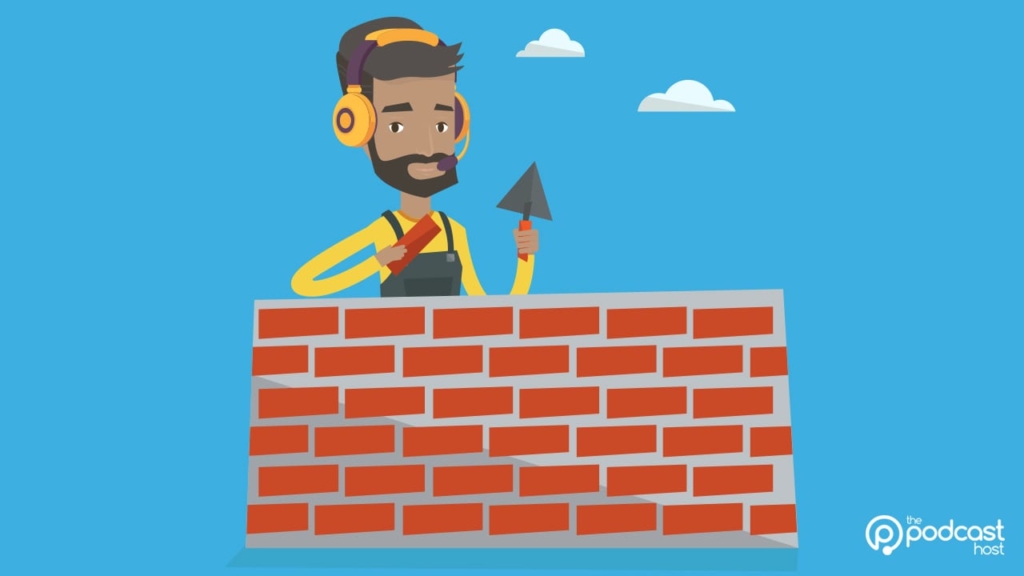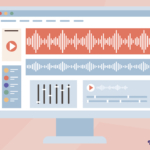What Podcast Bitrate Should I Use? Does It Even Matter?
What podcast bitrate should I use? This is one of those boring questions. Boring or not, though, it gets asked a lot in podcasting, and you’ll be asked it any time you go to convert a WAV to an MP3 format, too. So let’s get a definitive answer down on digital paper. Don’t worry, it won’t take long.
Oh, and if you want it even quicker, an answer that’s right for 9 out of 10 people, here you go:
Q. What Bitrate should I use for a podcast?
A. 96kbps mono.
Easy! But… there are a couple of caveats, so let’s cover them.

What is Bitrate?
Bitrate as a concept is actually pretty simple – it’s just a measure of the rate at which you can transfer bits. A bit is the smallest unit of data you can find, so that translates as the rate at which you can transfer data.
The common unit for audio is kilobits per second. So that means it measures how many thousands of bits are sent from one place to another every second.
When related to audio, this refers to how much of the detail of that audio, or how much of its complexity, we can store. A higher bitrate means storing more of the complexity, and a lower bitrate means less. As you’d imagine, that naturally translates to higher quality for higher bitrates, since it stores more of the detail of the original.
Higher bitrates store more data, though – more thousands of bits – and therefore lead to higher file sizes. And since we’re still sending this stuff over the interwebs, file size matters.
That’s why the whole argument arises: if we didn’t have to worry about file size, we’d use the highest bitrate we could. But we do, and therefore you have to find a balance between audio quality and file size.

What Are the Common Options?
To give you a bit of context, iTunes (the music side) delivers its audio files at 256 kilobits per second, or kbps. The perfectionists at Apple have obviously decided that rate is the lowest they can go while still delivering great audio quality for any type of music.
When you record a CD to MP3 format, the default tends to be in the range of 128kbps to 192kbps. Even the lower end of that range gives you a quality that the vast majority of people couldn’t distinguish from the original. So, for complex music and instruments, 192kbps still sounds great, and 128kbps is fine for the majority of us.
Voice is, arguably, less complex, containing a lower range of frequencies and a lower rate of change. Even the most prolific motormouth will struggle to compete with the speed and tempo of an epic guitar solo.
As a result, voice doesn’t need as high a bitrate to maintain high quality.
For a voice-only podcast, the common options are 64kbps or 96kbps, both mono (or joint stereo as Audacity calls it).
File Size and Bitrate
As I mentioned earlier, the whole reason this is worth discussing is that file size is a concern when sending things around online. You’re delivering your podcast, week after week, using up your bandwidth and theirs, and higher bitrates directly lead to higher file sizes.
Don’t forget, too, that you may be taking up your listeners time while they wait for a download. Sure, phones often sync and download shows when it’s quiet time, but In some cases people will download and listen instantly. In that case, they’re sitting there waiting for your file to arrive.
Add to this the fact that people are increasingly listening to podcasts via live stream. As 4G and 5G becomes more common, there’s less requirement to download in advance. Therefore, your listeners might care about the size of the file as they could be paying for it via their mobile plan.
Arguably, bandwidth and download speeds are becoming more and more irrelevant as time goes on. I remember when a 4MB MP3 took hours, not seconds, to download. So, as download speeds continue to grow, we could safely increase our podcast bitrate. But, would we want to? I’d still argue it’s worth being careful.
What Bitrate Should You Use for Podcasting?
In my opinion, there are three options, one of which will suit 90% of podcasters.
Main option: For the vast majority of us – that 90% – go for 96kbps mono. This is perfectly good quality for a voice-only podcast that has a little bit of intro music, some transitions and an outro. It gives enough quality that you could throw an extra tune or two in the background from time to time, but isn’t going to lead to big file sizes.
Second option: if you feel file size is a particular issue for your audience, you can go to 64kbps mono pretty safely. Or, if you don’t use music at all, this is the way to go. No need for that extra 32kbps.
Third option: if you’re creating more highly produced material with a lot of music, often as a background to voice sections (commonly known as a ‘bed’) then you might want to increase to 128kbps. The extra complexity that background music introduces can make it necessary to up the rate to make sure it sounds good.
Also, if you’re putting a lot more effort into production, then the sound probably matters a little more to your audience, so it could be worth the extra bandwidth.
How to Check the Bitrate of an MP3
If you have an existing audio file and you’d like to know its bitrate, then there are a couple of common ways of doing that.
On a Windows PC/laptop, right-click on the file and check the Details tab.
On a Mac, you can check the bitrate of an MP3 by using the iTunes desktop app. Open the file in iTunes, then go to the Library tab and select ‘Music’ from the dropdown menu. Find the file you want to check (it’ll appear in a list with your other audio files) then right-click, select ‘Song Info’ then ‘File’.
Constant Bit Rate or Variable Bit Rate for Podcasting?
This is a simple one: always choose constant bit-rate. Variable bit rate is good for complex stuff because the software tries to lower the bit rate when it can and save a few bytes.
But for the spoken word and the bitrates we’re using in podcasting, this isn’t necessary. Many media hosts advise against uploading variable bitrate files too, so always pick constant!
What About Sample Rate for a Podcast?
Sample rate is another number that comes up, but that too is easy. Choose 44.1khz and leave it be.
If you’d like to know more about sample rates though, then check out What does 44100Hz mean?
Summary: Podcast Bitrates
To finish up, I’ve got to say that bitrate is a really subjective thing. Some listeners wouldn’t be able to tell the difference between a 64kbps file and a 128kbps export, while someone really into their audio would argue that difference all day long.
My advice above is suited to the general podcaster out there who wants a good standard to work to. If you’re now seething because of what I’ve said, you’re no doubt an audiophile who loves audio with a passion, and quibbles over every little bit per second. In that case, you don’t need my advice though 🙂

Can I Automate Podcast Bitrates?
You can! Our ‘Podcast Maker’ tool Alitu was designed for folks who wanted to produce great-sounding audio without the slightest clue about how it all works. You upload your source files to Alitu, then it automatically sorts out all the cleaning up, volume levelling, and other complex processes. When you’re done, it’ll automatically set a podcast bitrate of 96kbps mono too – which is the optimal setting for the majority of podcasts.
If you need any more help with podcast bitrates – or any other aspect of podcasting, for that matter – be sure to check out Podcraft Academy too. In there, you’ll find all of our courses, tools, resources, and we run weekly live Q&A sessions too!

